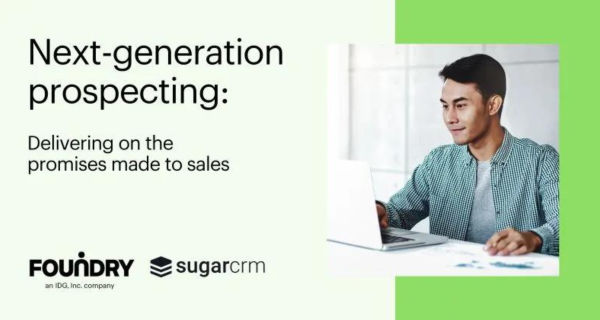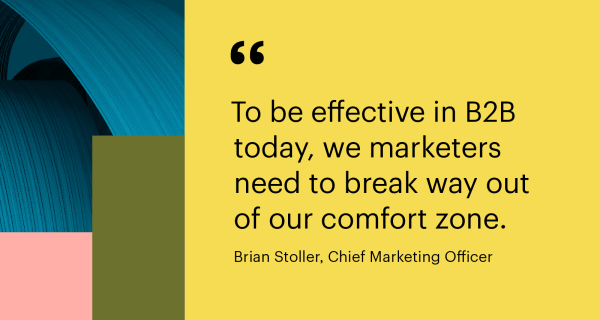European B2B technology companies continue to invest heavily in ABM for a good reason: they know that account-based strategies work.
This is the main conclusion of Foundry’s latest ABM and Intent Benchmarking Study. This year’s annual survey – the second in succession – finds that confidence in ABM strategies continues to ride high in Europe.
In this sense, European tech marketers resemble their counterparts worldwide. The vast majority (82%) describe ABM as “extremely” or “very” successful. 9 out of 10 believe that ABM plays a highly important role in achieving marketing objectives. Around half of respondents told us that ABM outperforms traditional go-to-market strategies in terms of return on investment, win rate, up-selling, cross-selling, new business acquisition and deal size.
The verdict was very similar last year. In the meantime, we have seen sustained investment in ABM strategies and a substantial expansion in the use of intent data. On average, ABM now accounts for over half of all marketing expenditure (52%) among the B2B technology companies we surveyed in the region. Eight out of ten respondent organisations are using intent data for prioritising accounts and/or making decisions on which content to serve.
This blog post looks at what the survey tells us about how European B2B tech firms are using ABM and how they describe their investment intentions for the year ahead. It also examines some of the ways in which the market for ABM in Europe differs from its equivalent in North America. Throughout, you’ll find our recommendations for European ABM teams in 2023, which draw on both these research findings and discussions we’re having with customers right now.

What Europe has in common with North America
First, let’s look at what European technology marketers tell us about their ABM operations. We asked which elements of ABM functionality organisations are using. From target account lead generation to campaign orchestration, the answers from Europeans closely followed those of their North American counterparts. Despite a few differences, the story was broadly similar when we asked Europeans and North Americans how they measure the success of their ABM efforts.
Levels of technology usage looked similar, too. In both Europe and North America, a majority of marketers told us they used two to three different technologies to drive ABM strategies (although it’s worth noting that European tech companies are more inclined to use marketing automation and ABM platforms).
How do European respondents differ from their counterparts in North America? In many cases, the differences are subtle, but in some cases, they are substantial. The nature of the differences varies as well: some seem to be cultural, while others are structural (i.e. the context in which ABM is practised).
One example of a structural difference: during 2022, an increasing number of technology companies worldwide set up dedicated ABM teams (as opposed to sharing out ABM duties across the marketing organisation, for example). At the same time, those teams have grown larger. Two-thirds of respondents’ organisations worldwide now operate dedicated ABM teams with three or more staff, compared to less than half in last year’s survey.
The point to notice is that European ABM teams tend to be larger than North American teams. However, there’s a trade-off involved here. In European teams, ABM experience levels are also likely to be lower. In other words, these larger European teams typically contain fewer experienced practitioners and more inexperienced ones. In Europe, for example, the number of practitioners with just 6-12 months experience (33%) is a good deal higher than in North America (18%).
What does this mean for ABM professionals?
- For many ABM teams in Europe’s tech sector, 2022 was a year of recruitment. 2023 should be a year of upskilling. Teams that are reliant on relatively inexperienced ABM practitioners need to accelerate formal training and expand the potential for ABM innovation.
- Within European ABM teams that staffed up last year, 2023 will be the right moment to re-evaluate existing ABM platforms. The need to do more with less will become pervasive in 2023. When we talk with prospects, we’re already hearing questions like these: does our ABM platform allow our team, with its existing skills, to operate with maximum efficiency? Does it allow them to orchestrate data across multiple channels? Are we getting the kind of insights about potential buyers identified by behavioural data that allow us to make informed business decisions that maximise ABM ROI?

The benefits of ABM maturity
Less experienced ABM teams worry more about operational challenges. In Europe, nearly half (49%) of respondents say that prioritising accounts is a challenge. The second most frequently identified challenge in Europe is creating target account lists (a challenge for 35%). European marketers are also inclined to worry about gaining sales buy-in (31%).
North Americans feel similarly in one sense. The ABM challenge identified by most – as in Europe – was a tactical one: prioritizing accounts (44%). But in other respects, their concerns differ. For North American respondents, the next most-frequently identified challenges are gaining C-Level involvement (38%) and the need to reach and engage target accounts (34%). American respondents are less concerned than Europeans about sales buy-in (only 24% cited this as a challenge).


A similar pattern of differences emerged when we asked about the challenges of using intent data. Respondents from North America most frequently highlighted two knotty conceptual challenges: converting data into insights and verifying the validity of intent signals. Their European counterparts identified something a good deal more fundamental: the challenge of creating a strategy around intent data.
The evidence suggests a significant difference in maturity levels between Europe and North America – and a continuing need for professional development. These needs look substantial in Europe, but shouldn’t be underestimated in North America, either. In both regions, ABM remains a maturing discipline. The upside is the potential for knowledgeable and well-resourced ABM teams to gain a significant competitive advantage over rivals.
ABM teams that find basic tasks challenging are right to be concerned about the results of their ABM programs. Notably, European respondents are not as convinced as the North American counterparts about the extent to which ABM improves sales velocity compared with traditional go-to-market techniques. Likewise, they are somewhat cooler than their North American counterparts (though still enthusiastic overall) when answering questions about how much value ABM contributes to their organisation, or how successful their ABM efforts have been.

What does this mean for ABM professionals?
- Address major operational challenges where they exist, including account prioritisation and creating target account lists. If you are not already using an ABM platform, investigate the advantages of using one to simplify and automate tasks like these. If your team is using an ABM platform, assess ease-of-use: does your platform really make these tasks easier?
- Pay close attention to the intent data sources you use (not all intent data is created equal). Aim to combine multiple types: the more comprehensive your view of the buyer’s purchase journey, the better positioned you will be to deliver the right messaging at the right time.
Expectations & innovation
Perhaps our European respondents are more reserved about the outcomes of ABM programs because their expectations tend to be high. One example: for obvious reasons, improved new account acquisition typically ranks high in the list of business goals marketers set for ABM. In North America, 67% of respondents identify this as one of their key business goals for ABM. In Europe, 80% do so.
Another point of difference: over half of North Americans (51%) strongly agree that they are adding more tactics to their programs as their ABM operations mature. Only one-third of Europeans (35%) strongly agree with the same statement.
The difference is subtle. It may be partly cultural: quite possibly, Europeans dislike agreeing strongly with statements placed in front of them by market researchers. On the other hand, it may be that inexperience, and/or sub-optimal tools, are inhibiting innovation.
What does this mean for ABM professionals?
- ABM is still a relatively young discipline. The best ABM teams develop an internal culture of continuous testing, sharing and learning, often sponsored by one or more senior managers. What would this approach look like in your organisation?
- Innovation becomes increasingly possible when routines are automated. Define and refine your data strategy with the help of an ABM platform that allows your team to launch and manage campaigns more efficiently. In particular, work with a platform that offers the right data sets for the European market and which allows ABM team members to manage complexity without the help of an intent data expert.
The sales-marketing relationship
It’s important not to focus too much on these contrasts, precisely because levels of enthusiasm for ABM remain so high overall. Occasionally, however, the survey data reminds us that ABM is a complex undertaking, and, for some, a novel one. One moment of this kind is the revelation that roughly one-third of respondents consider “understanding how it all works” as one of the biggest challenges they will encounter during the next 12 months (27% in North America and 31% in Europe).
Another challenge that European and North American ABM teams have in common is their relationship with sales management. We’ve already seen how European respondents worry slightly more about sales buy-in. However, an additional set of questions in the survey ask about the extent to which sales leaders are involved in building ABM programs driven by intent data. Regardless of location, only around one-quarter of organisations sustain sales-marketing collaboration throughout the program set-up phase. The numbers in North America are as poor as those in Europe.
What does this mean for ABM professionals?
- Without sales buy-in, ABM risks becoming less than the sum of its parts. Getting – and maintaining – that buy-in is typically a long-term, incremental, process. Like any commercial partnership, the key lies in providing consistent and predictable value. One good place to start: bring sales leaders into discussions about ABM’s point of departure: the sourcing, exploitation, and evaluation of data.
- Successful ABM programs often rely upon wider cross-departmental collaboration. Making an ally out of a senior management stakeholder who is committed to the success of ABM can help with accelerating workflows. Technology can help here, too: specifically, an ABM platform that is designed for both sales and marketing, and which helps with alignment by centralising workflows.
Resourcing for the future
The good news is that most European and North American tech marketing organisations possess the resources required to address these challenges.
In 2021 and 2022, our surveys asked respondents about investment intentions over the previous 12 months and the next 12 months. As a result, we are now able to assess fluctuations in ABM investment intentions over a three-year period.
The survey data suggests that we have seen a significant wave of investment in ABM since 2021. If anything, this surge appears to be intensifying.
In 2020-21, the year of lockdowns, ABM investment declined in more European companies than American ones. Similarly, investment intentions among what we call the super-spenders were less bullish in Europe than in North America. (We define ABM super-spenders as marketing organisations planning or achieving a 50%+ year-on-year increase in ABM-related investment.)
In the year (2021-22) covered by this new survey, respondents reported a significant rebound in the quantity and size of ABM investments made by European tech companies. The number of organisations cutting ABM budgets is in decline. In addition, the proportion of European super-spenders recovered to levels that now bear comparison with North America.

In Europe, accelerating investment should help to drive up levels of ABM maturity. In many cases, this will rely upon the diffusion of best practice. Already, our 2022 survey suggests increasing convergence between the way ABM gets done in North America, Europe, and Asia Pacific.
Nevertheless, the European market remains distinctive. European practitioners often structure ABM teams differently, staffing them with less experienced hires. Europeans are also more likely to be worried about sales-marketing misalignment than their North American counterparts. Clearly, Europeans think differently about the challenges of ABM, and tend to be less ecstatic when assessing outcomes. Amid accelerating investment, the way that European B2B technology companies approach ABM continues to look separate and distinct.
One final thought about 2023
Given the backdrop of historic budget growth and economic uncertainty, 2023 is also likely to be a year in which ABM teams in Europe need to demonstrate their value. Hiring freezes and workforce reductions mean that less experienced European ABM teams could find it challenging to add experienced headcount. Under these circumstances, an ABM platform that bridges the skill gap by putting data to work efficiently and enabling automated orchestration becomes a compelling proposition.
We’ve got both halves of that equation covered. We also specialise in delivering high-quality European intent data that’s fully compliant with local data protection rules. (In Europe, very few of our US-based rivals can compete with our offering especially when it comes to getting access to actionable intent data.
If you want to make 2023 a year of improved execution and better ROI in Europe, please get in touch. There’s nothing we like better than helping marketers to turn ambitions into reality.
About the survey
Foundry’s ABM & Intent Data Benchmarking Study 2022 was completed in September 2022 and is based upon the views of 500 technology industry marketers based in North America, Europe, and Asia Pacific. Download the full findings here: ABM & Intent Benchmarking Study




